Arkansas is called “the natural state.” You will understand why when you see its wealth of nature. Blessed with the Ozark mountains on one side and the Ouachita mountains on the other, it deserves the identity. Arkansas also has deep valleys, rushing mountain streams, densely forested timberlands, and fertile lowlands with rich black soil. There is no doubt that this is a desirable habitat for animals in the wild. And indeed, there are hawks common to Arkansas.
Hawks are elegant creatures, but they are notorious as birds of prey. Their sharp, curved talons and beaks make them powerful animals with fantastic hunting skills. They belong to the family Accipitridae. There are about 270 species of hawk globally—all classified as raptors or birds of prey. However, they vary in shapes, sizes, colors, and behaviors.
If you love to watch and observe these elegant creatures, some of the details discussed below will help you identify the hawks you see, how to look out for the ones you have never seen, and where to find the hawks you are looking for.
Let’s discuss ten species of hawk that are common in Arkansas!
1. Red-tailed Hawk
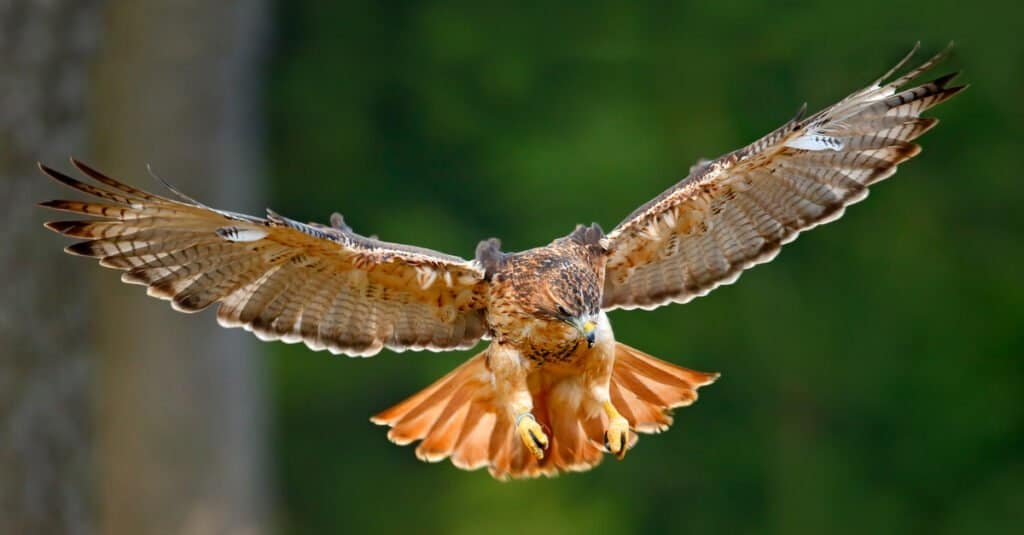
The red-tailed hawk is a major prey and diet for great-horned owls and bobcats.
©Ondrej Prosicky/Shutterstock.com
| Red-tailed Hawk | |
|---|---|
| Scientific name | Buteo jamaicensis |
| Weight | 1.5-3.5 lbs (680-1586 g) |
| Height | 18-26 in (45-65 cm) |
| Wingspan | 43-56 in (110-141 cm) |
Red-tailed hawks are the most common in North America. So, even when traveling outside the state, you can be sure that you will spot one. Their circular flight pattern on open fields is one easy way to identify them when you see one. And other times, you can see them as they sit on a pole to watch prey.
Their distinctive feature is a short and wide red tail, which is how they got their name. Their wings are large and rounded like those of a goose. They have a brown back and are pale underneath with a streaked belly.
Red-tailed hawks prefer mammals for their diet. Dogs and cats are excluded but feed on moles, ground squirrels, rabbits, small raccoons, mice, and voles. The red-tailed hawk is a major prey and diet for great-horned owls and bobcats.
Red-tailed hawks nest on top of the tallest buildings, cliff ledges, and trees. Females lay between 2-3 whitish-brown blotched eggs. They incubate for about 28 to 35 days.
Do not expect to see them in your backyard unless you have a large one. But if you want to see these birds, you can go on a long walk or drive—your chances of seeing a red-tailed hawk increase in winter when birds migrate towards a specific climate.
2. Red-shouldered Hawk
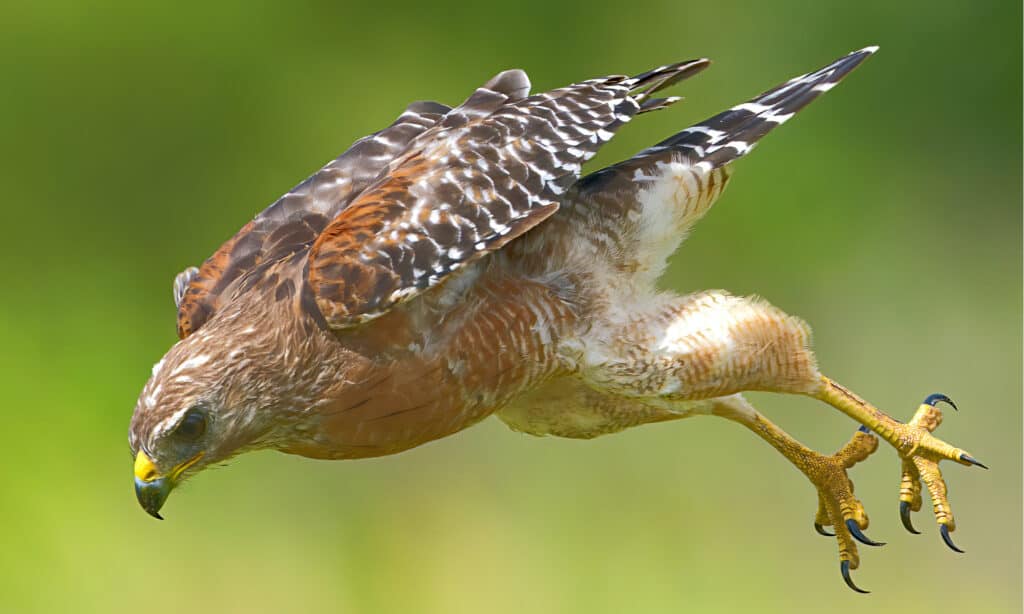
Red-shouldered hawks prey on reptiles, rodents, rabbits, crayfish, amphibians, and other small mammals.
©Chase D’animulls/Shutterstock.com
| Red-shouldered Hawk | |
|---|---|
| Scientific name | Buteo lineatus |
| Weight | 1-1.7 lbs (486-774 g) |
| Height | 15-24 in (38-61 cm) |
| Wingspan | 35-50 in (90-127 cm) |
Red-shouldered hawks are common in suburban areas, wooden swamps, and deciduous forests. They derive their name from their red-colored wings, while the rest of their bodies have beautiful white and black feathers.
These hawks prey on reptiles, rodents, rabbits, crayfish, amphibians, and other small mammals. However, they are threatened by humans, snakes, peregrine falcons, martens, and fishers.
Red-shouldered hawks inhabit wet areas and are known for flying close to the ground. They make their nests in tree crotches. They are monogamous, and they start breeding once they are two years old. Their female lays 2-5 white or bluish eggs. Their incubation period is about 33 days.
3. Northern Harrier

Northern harriers are slender, medium-sized birds of prey with rounded tails and broad wings.
©Harry Collins Photography/Shutterstock.com
| Northern Harrier | |
|---|---|
| Scientific name | Circus hudsonius |
| Weight | 11-27 oz (300-750 g) |
| Height | 21-25 in (53-64 cm) |
| Wingspan | 41-46 in (103-117 cm) |
Northern harriers are slender, medium-sized birds of prey with rounded tails and broad wings. They have striking owl-like faces. You can easily spot them gliding low over grasslands or marshes.
These hawks prey on small birds and small mammals, but they also carry bigger prey like ducks and rabbits and kill them by drowning them. Their diets change through different seasons and are affected by location as well. They fly back and forth over the ground while watching and listening for small animals for their meal. They are like owls when it comes to using their sharp hearing sense to hunt.
Northern harriers live in marshes, prairies, and open fields. They conceal their nests on the ground and perch in colonies. Females lay 2-4 eggs, which hatch in 30-32 days.
4. Cooper’s Hawk

Cooper’s hawks’ predators are eagles and other larger birds of prey.
©Richard G Smith/Shutterstock.com
| Cooper’s Hawk | |
|---|---|
| Scientific name | Accipiter Cooperii |
| Weight | 7.8-14.5 oz (220-410 g) |
| Height | 14-20 in (35-50 cm) |
| Wingspan | 24-39 in (62-99 cm) |
The Cooper’s hawk is a bird of prey with a small-medium size. Cooper’s hawks have wide-rounded wings and large shoulders. They are the size of crows with the appearance of sharp-shinned hawks.
These hawks mainly eat woodpeckers, quails, plump fowl, chickens, and smaller mammals. They are watchful birds and spend many hours in woodland canopies waiting for prey. Their camouflaged feathers enable them to disappear among the tree branches.
Generally, Cooper’s hawks’ predators are eagles and other larger birds of prey. Their primary threat is the widespread use of pesticides, which has destroyed thousands of hawks and other predatory animals.
Cooper’s hawks only stick to one mate per season. They nest on flat grounds in deep forests, not on hillsides. Females lay 2-6 blue or bluish-white eggs and are in charge of incubation. Incubation takes about 30-36 days.
5. Sharp-shinned Hawk
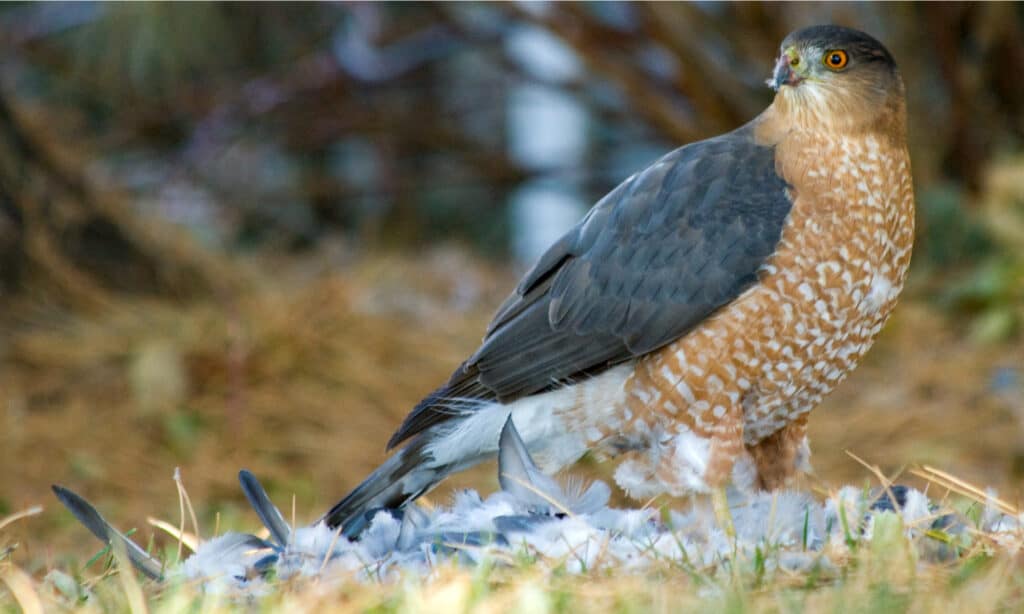
Sharp-shinned hawks inhabit the deepest ends of the forests and can only be sighted high in the sky or in open habitats during migration.
©Wyatt W/Shutterstock.com
| Sharp-shinned Hawk | |
|---|---|
| Scientific name | Accipiter striatus |
| Weight | 2.9-7.7 oz (82-219 g) |
| Height | 9.1-15 in (23-37 cm) |
| Wingspan | 17-27 in (42-68 cm) |
Sharp-shinned hawks are small, long-tailed hawks with rounded wings and square-tipped tails. Typically, they weigh less than a pound. They have tiny heads that are scarcely visible when flying in the sky. They get their name from the nature of their sharply keeled, featherless legs.
Sharp-shinned hawks fly at about 60mph through dense forests to surprise their prey. Their flap-and-glide flight style is unique and outstanding. They feed primarily on small birds like songbirds and quails. Giant insects, snakes, frogs, squirrels, and rodents are included in their meal plan.
These hawks inhabit the deepest ends of the forests and can only be sighted high in the sky or in open habitats during migration. They build their nests in conifer trees, usually on top of the tallest trees with dense cover. Females lay between 4 and 5 eggs, which take about 30–32 days to hatch.
6. Broad-winged Hawk
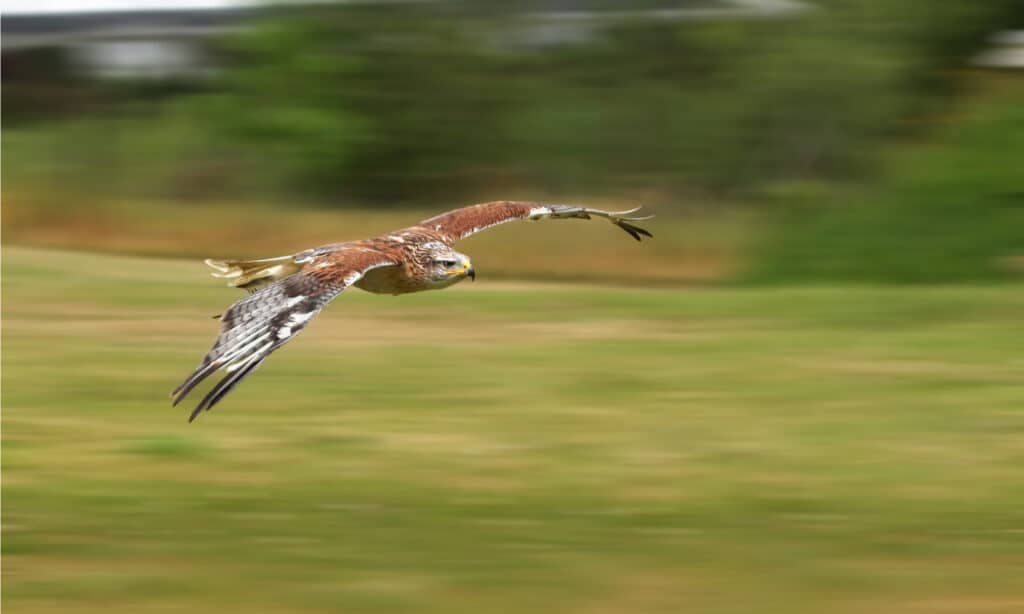
Broad-winged hawks are small hawks with broad wings.
©pr2is/Shutterstock.com
| Broad-winged Hawk | |
|---|---|
| Scientific name | Buteo platypterus |
| Weight | 9.3-19.8 oz (264-561 g) |
| Height | 13.4-17.3 in (34-44 cm) |
| Wingspan | 31.9-39.4 in (81-100 cm) |
Broad-winged hawks are small hawks with broad wings. They look like red-shouldered hawks but with brown coloration. They can only be found during the breeding season from April to August.
These hawks are medium-sized birds of prey with compact, stocky bodies like those of geese and crows. Their diet consists of snakes, lizards, young turtles, frogs, and other small mammals.
Adult broad-winged hawks are sometimes preyed on by other hawks, eagles, and great horned owls. Their other biggest threats include collisions with vehicles, poisoning, hunting, and habitat destruction.
The females lay between 1 and 4 eggs, and the eggs are usually whitish with brown spots. The incubation period lasts for about 28-31 days. Both sexes take care of their young until they can fly and hunt for themselves.
7. Swainson’s Hawk
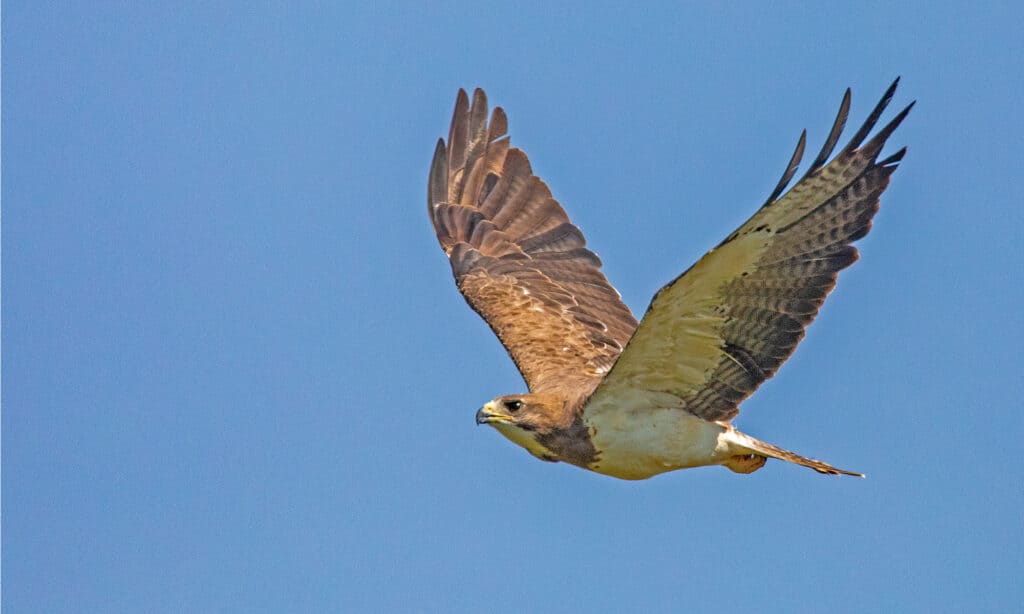
Swainson’s hawks were named after William Swainson, a British naturalist.
©Lowell Monke/Shutterstock.com
| Swainson’s Hawk | |
|---|---|
| Scientific name | Buteo swainsoni |
| Weight | 1.1–3.7 lbs (499-1678 g) |
| Height | 17-22 in (43-56 cm) |
| Wingspan | 46-54 in (117–137 cm) |
Swainson’s hawks were named after William Swainson, a British naturalist. They are frequently seen during summer.
These hawks have light-colored bellies but are usually darker in their chest areas, with colors that range from reddish-brown to grey. The males have grey heads, and the females mostly have brown heads. They appear more frequently in April and September. During these periods, you can see them perched on trees or telephone poles.
Swainson’s hawks enjoy migrating from time to time. Their diet consists of rodents, reptiles, and rabbits. So when you see them perched on a tree, a fence post, or a telephone pole, you know they are scanning for their meal.
For reproduction, their females lay between 2-3 pale bluish-white eggs that take about 34-35 days to hatch.
8. Rough-legged Hawk

Rough-legged hawks are medium to large, with broad but thin wings.
©Eivor Kuchta/Shutterstock.com
| Rough-legged Hawk | |
|---|---|
| Scientific name | Buteo lagopus |
| Weight | 1.32-3.66 lbs (599-1660 g) |
| Height | 18-24 in (46-60 cm) |
| Wingspan | 52-54 in (132-138 cm) |
The rough-legged hawk was named so because of its feathered legs. It shares this feature only with the ferruginous hawk. Rough-legged hawks are medium to large, with broad but thin wings. They fly facing the sky – you can identify them by their flight pattern.
Their proper diet consists of rodents, lemmings, and voles, and they occasionally feed on birds and amphibians.
These hawks inhabit the arctic tundra during summertime to hunt prey and raise their young ones. Females lay 3-5 pale bluish-white eggs incubated for about 31 days.
9. Northern Goshawk
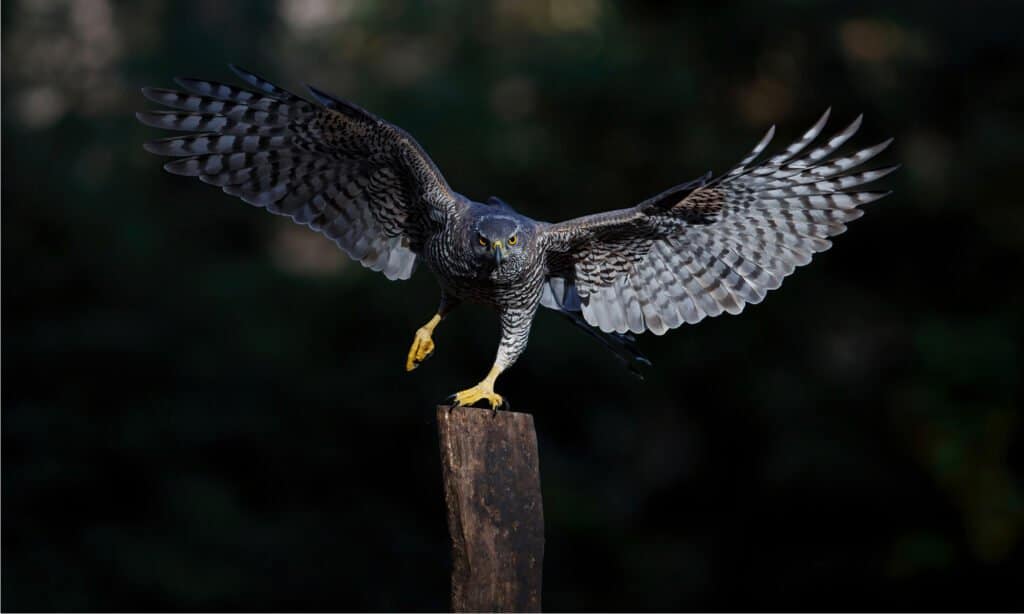
Northern goshawks’ diet consists majorly of small birds, mammals, carrion, and insects.
©Henk Bogaard/Shutterstock.com
| Northern Goshawk | |
|---|---|
| Scientific name | Accipiter gentilis |
| Weight | 1.4-4.8 lbs (635-2177 g) |
| Height | 18-27 in (46-69 cm) |
| Wingspan | 40-46 in (103-117 cm) |
The name “goshawks” refers to a combination of “goose hawks.” Northern goshawks are large birds of prey, similar to red-tailed hawks. Adult goshawks are dark slate gray with pale gray underparts.
Northern goshawks are scarce to find around here. To see them, you will have to walk into a mature forest. They live in large tracks of mostly coniferous or mixed forests. They live on trees, protect their young, and are opportunistic feeders.
Their diet consists majorly of small birds, mammals, carrion, and insects. Northern goshawks breed yearly, usually between early April and mid-June. Their eggs are bluish-white with a 28-38-day incubation period.
10. Ferruginous Hawk
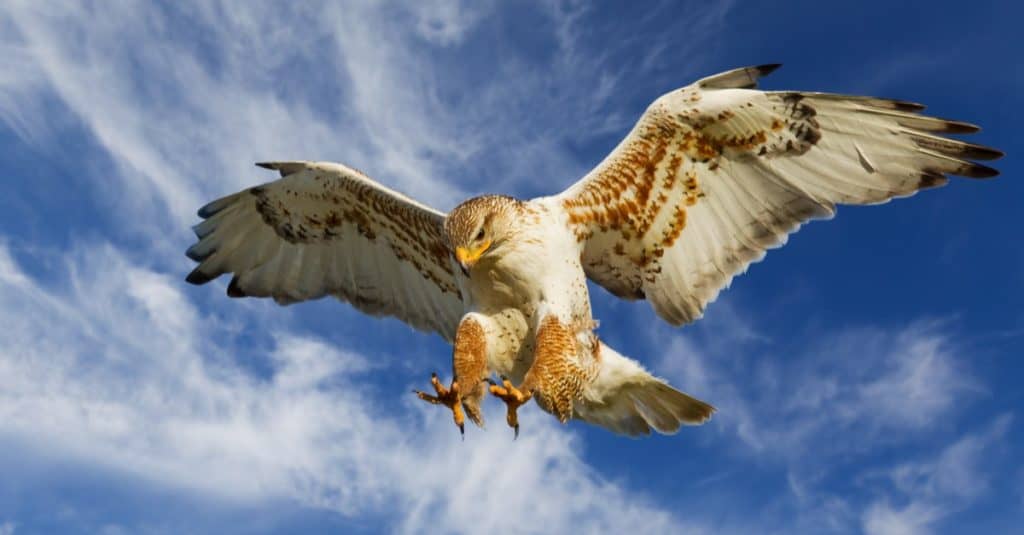
Ferruginous hawks eat mice, squirrels, rabbits, hares, gophers, reptiles, amphibians, small birds, and even insects.
©Stephen Mcsweeny/Shutterstock.com
| Ferruginous Hawk | |
|---|---|
| Scientific name | Bluteo regalis |
| Weight | 32 to 80 oz (907 to 2,268 g) |
| Height | 20 to 27 in (51 to 69 cm) |
| Wingspan | 52-56 in (133-142 cm) |
The bird’s name is derived from the Latin word “ferrum,” meaning iron. Ferrum describes the rusted iron color of its feathers. Their unique color pattern, large size, and feathered legs help identify them.
Ferruginous hawks are the largest hawks in North America. They have large heads and long wings. They come in a light and dark morph, varying considerably in the color pattern.
The more common light morph ferruginous hawks have white underwings, belly, and head. Their backs and the upper sides of their wings are rusty brown, and they have darker legs.
These hawks eat mice, squirrels, rabbits, hares, gophers, reptiles, amphibians, small birds, and even insects. When they catch their prey, they either swallow it whole or tear it apart with their beak.
They have no significant predators, considering how large they are. But their nesting activities are threatened by overgrazing and agricultural activities. They are also disturbed by golden eagles in territorial disputes, and bobcats are threats to juveniles.
The females lay 3-5 eggs, which take about 32 days to hatch. The males also help incubate and brood the hatchlings until they learn how to fly at around 5–6 weeks.
The photo featured at the top of this post is © pr2is/Shutterstock.com
Thank you for reading! Have some feedback for us? Contact the AZ Animals editorial team.






